Answered step by step
Verified Expert Solution
Question
1 Approved Answer
Problem 1 . We wish to estimate the dynamics of a cold thermocouple probe suddenly placed in a hot flowing fluid stream for the purpose
Problem We wish to estimate the dynamics of a cold thermocouple probe suddenly placed in
a hot flowing fluid stream for the purpose of temperature measurement. The probe consists of
two dissimilar metal wires joined by soldering at the tip, and the wires are then encased in a
metal sheath and the tip is finally coated with a bead of plastic to protect it from corrosion. Take
the mass of the soldered tip plus plastic bead to be m with a specific heat C p Denote the transfer
coefficient as h
a If the effects of thermal conductivity can be ignored, show that the temperature response
of the probe is described by:
where A denotes the exposed area of probe tip, and Tt is its temperature.
b Lump the explicit parameters to form the system time constant, and define a new variable
T T f T and show that the compact form results
To do this you will need to show that the system time constant is defined as:
c Integrate the expression in b using the initial condition T To and show that:
d Rearrange the expression in c to obtain the solution below.
mC p
dT
dt hAT f T
tau dT
dt T
tau mC p
hA
T T f
T T f
exp t
tau
T T
T T f
exp t
tau
e What does the solution look like? Plot this up in Maple to find out. Show that the
temperature excess is of the final steadystate after a time equivalent of one time
constant has elapsed.
Problem An iron bar cm x cm x cm at a temperature of o C is dropped into a barrel of
water at o C The barrel is large enough that the water temperature rises negligibly as the bar
cools. The rate at which heat is transferred from the bar to the water is given by
QJmin hAT b T w
Where U Jmincm o C is a heat transfer coefficient, A cm is the exposed area of the
bar, T b is the surface temperature of the bar, and T w is the water temperature. Given that the
heat capacity of the bar is Jg o C and heat conduction in iron is fast enough to assume that
the temperature T b t is uniform throughout the bar, write an energy balance on the bar and
determine the steadystate temperature of the bar. Also, calculate the time required for the bar
to cool to o C
Problem A steel ball initially at a uniform temperature of o C is dropped into an insulated
vessel containing water at o C Derive the appropriate governing equations for the temperature
of the steel ball T b and the temperature of the water T w Determine the transient and steady
state solutions for the temperature of water and steel ball as a function of the system
parameters. Plot these profiles for the set of parameters with the mass of the ball mb kg
the mass of the water mw kg and the specific heats Cb Jgo C C w Jgo C and hA
the heat transfer rate Js o C What do you observe?
Problem An aluminum plate is at a temperature of o C The plate is then suddenly subjected
to a uniform and continuing heating at the rate of Wm Develop a macroscopic model for the
process. Find the time at which the surface temperature reaches a value of o C What is the
total heat transferred up to this time? Assume a plate thickness of cm and that the heat
conduction is fast enough to assume the temperature is uniform throughout the plate.
Problem Derive the governing differential equation for the concentration in a plugflow ie
constant velocity reactor if the reaction rate is of a second order and b zeroth order. Render
each of these equations dimensionless and solve them numerically in Maple. Plot each solution
as a function of the dimensionless plugflow reactor axial distance
Step by Step Solution
There are 3 Steps involved in it
Step: 1

Get Instant Access to Expert-Tailored Solutions
See step-by-step solutions with expert insights and AI powered tools for academic success
Step: 2

Step: 3

Ace Your Homework with AI
Get the answers you need in no time with our AI-driven, step-by-step assistance
Get Started


